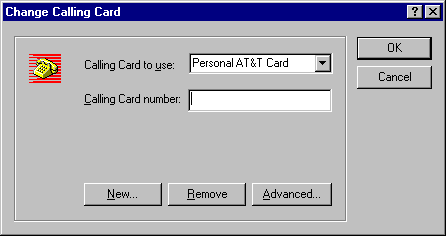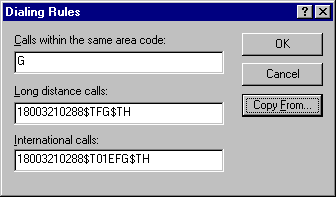
A calling card is information that Dialing Properties uses to create the sequence of numbers to be dialed on a particular call. The calling card can include a calling card number that can be dialed at a specified time during call placement. However, the calling card does not have to specify a card number (in other words, calling cards can also be used to define alternative procedures for direct dialing without a calling card number). To help you remember them, you can name calling cards anything you choose.
Dialing Properties includes predefined settings for several popular calling cards used in the United States, including AT&T®, Sprint, MCI, British Telecom, France Telecom Mercury, Telecom New Zealand, and others. You can modify and use these directly or copy them to create your own calling cards. Dialing Properties allows you to add new calling cards, edit existing calling cards, and remove calling cards you do not need.
The information stored in a calling card includes the name, card number, and the dialing rules for local, long-distance, and international calls.

You can also customize dialing rules by clicking the Advanced button in the Change Calling Card dialog box. The following two examples illustrate how you might use dialing rules.
If you are making a calling-card phone call from outside the United States and do not want Windows telephony applications to automatically add a "0" prefix to the number you are calling, precede the phone number with another numeric code, such as "144" in the following example.

Code | Description |
E | Country code |
F | Area code |
G | Destination local number |
H | Calling card number |
W | Wait for a second dial tone |
@ | Wait for a ringing tone followed by five seconds of silence |
$ | Wait for a calling card prompt tone (if your modem supports it) |
? | Display an on-screen prompt to the user to continue dialing |
For example, if you are using a British Telecom card, you need to precede the number you dial with 144 and complete the fields as follows.
Option | Type |
Calls within the same area | 144,H,G |
Long-distance calls | 144,H,0FG |
International calls | 144,H,00EFG |
When you choose the Dial option from Phone Dialer or HyperTerminal, the tool you are using automatically expands this number to include "144" and the card number, plus the pause codes.
In another scenario, suppose your organization in the United States uses a PBX system and you need to omit the "1" prefix before the area code. Create a calling card as in the following example.
Option | Type |
Calls within the same area | G |
Long-distance calls | FG |
International calls | 011EFG |